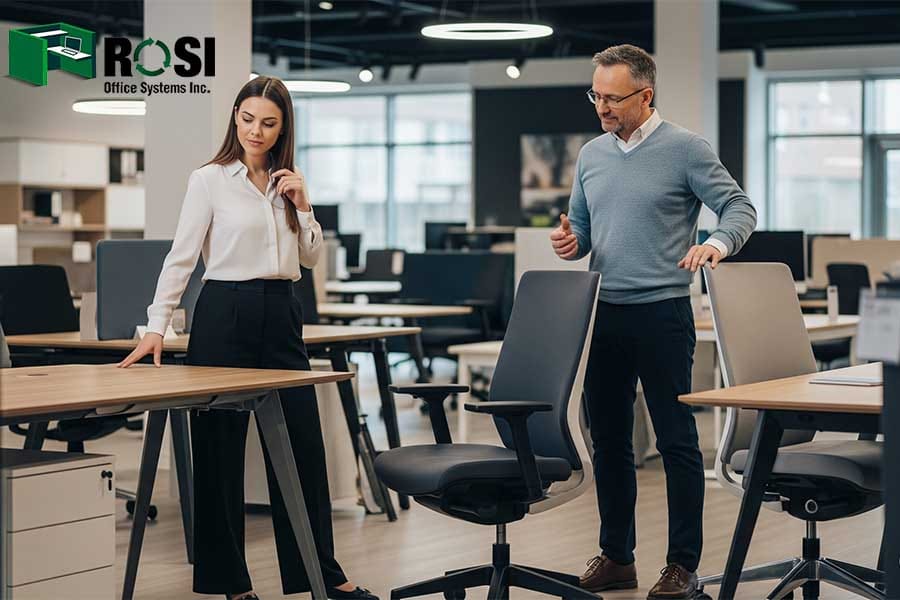
In 2026, with widespread changes in working styles and an increased emphasis on employee health and comfort, selecting the right office furniture is more crucial than ever.
The dynamics of your workspace can have a direct impact on the productivity, creativity, and satisfaction of your employees.
The 2026 Office Furniture Buying Guide emphasizes the importance of ergonomics, sustainability, and flexibility in supporting employee well-being and productivity in hybrid workspaces.
Key points include choosing ergonomic chairs and desks, using biophilic design, employing eco-friendly materials, and modular and expandable furniture that can easily adapt to changing business needs.
According to a report by the American Society of Interior Designers (ASID), 90% of employees report that office design directly affects their productivity.
This 2026 guide will help you make the best choices for your office by considering the important factors we mentioned and budget management to create a space that increases people’s motivation and productivity.
In this ultimate guide to buying modern office furniture in 2026, we answer the following essential questions:
How do we choose furniture that supports the health and ergonomics of our employees?
Which options give us the flexibility to adapt to future changes?
How can we integrate smart and sustainable technologies into our office space?
Let’s see together how to transform your office into an inspiring and efficient space with the right furniture choices.
Step 1: Assessing Your Current and Future Needs
Before you purchase office furniture, it is necessary to base your decision-making carefully and consciously.
This stage is like designing a building because if the infrastructure is not laid out properly, costs will increase, and the final result will deviate from your actual needs.
1. Space Analysis
Before purchasing office furniture, you need to carefully measure the available space in your office.
Having an accurate map of the dimensions of rooms, hallways, doors, and windows will help you ensure that the furniture you choose fits your workspace in terms of size and layout.
In addition, it is very important to examine the flow of people in the environment and the functional division of space.
Functional separation makes choosing the type of furniture for each section more purposeful and efficient.
The important thing is to remember to think about the future and choose furniture that can be expanded, adjusted, or moved if the number of employees increases or decreases or the work structure changes.
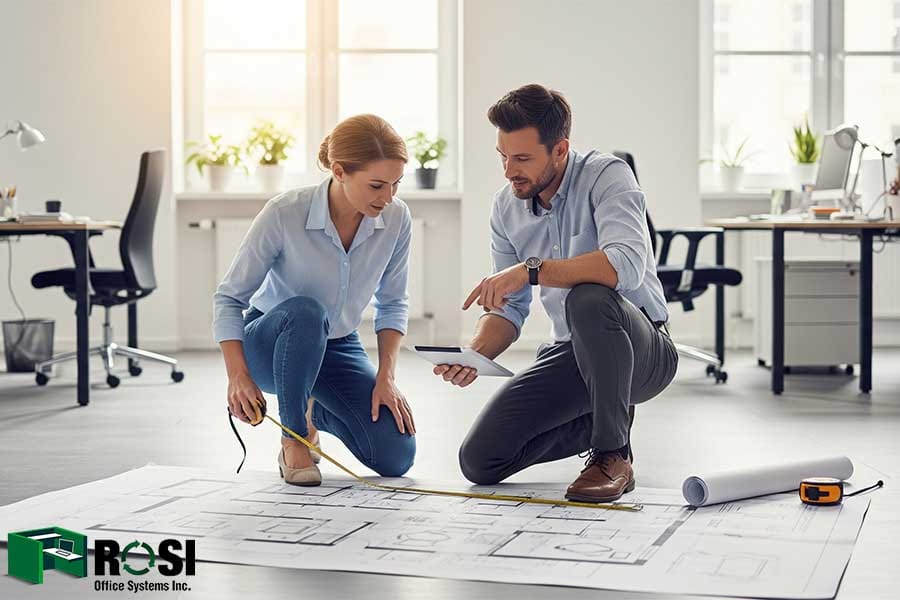
2. Workforce Demographics and Preferences
In the process of selecting office furniture, it is very important to pay attention to the physical characteristics of employees and their job needs.
Employees vary in height, weight, and physical abilities, so furniture should be adjustable and adaptable to different conditions.
Also, the type of duties has a direct impact on the type of office furniture required.
At this stage of buying office furniture, one of the most effective ways to accurately understand needs is to survey employees.
By asking questions about the reasons for their discomfort, their expectations of the workspace, and their preferences in choosing desks and chairs, you can avoid making the wrong purchases and provide an environment that fits the working realities of your organization.
3. Budgeting and Financing
Determining a realistic budget is one of the most essential steps in the office furniture purchasing process.
Before contacting a supplier or visiting a store, you should clearly define how much you have budgeted for each piece of furniture.
It is also very important to identify sectors that require more investment.
Along with these, you should also consider the concept of return on investment (ROI).
Although buying cheap office furniture may seem appealing at first, in the long run, it can lead to hidden costs, employee dissatisfaction, and reduced productivity.
Furniture that has high quality, long durability, ergonomic features, and a reliable warranty can be a smart investment.
You can take advantage of various purchasing models—such as outright purchase, monthly rental, rent-to-own, or even full-service subscription plans—each offering its own set of advantages and disadvantages.
You Might Also Enjoy: BuzziSpace Acoustic Office Furniture – 2026 Review
Step 2: Defining Your Office Culture and Aesthetic
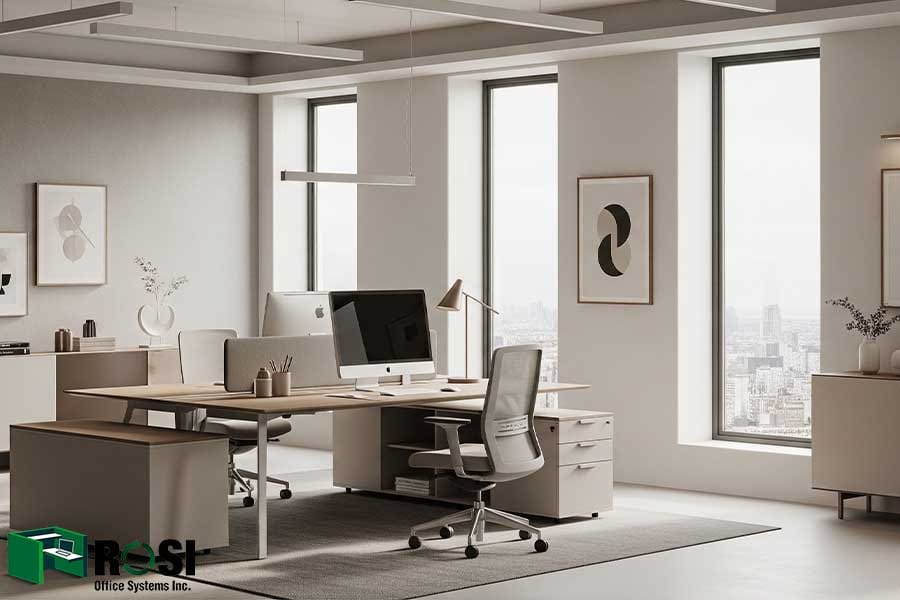
1. Brand Alignment
Office furniture and interior design should be a reflection of your brand’s culture and personality.
Before choosing a design style and buying office furniture, ask yourself if our company is formal, creative, innovative, or friendly.
How well do the colors and materials match our logo and brand personality?
Ultimately, the design should be such that it both conveys the brand’s personality at first glance and provides a pleasant work experience for employees.
2. Design Trends for 2026
To keep up with the modern and futuristic workplace, it is important to pay attention to emerging design trends in 2026.
These trends affect the aesthetics of the workplace and play a significant role in improving employee experience, increasing productivity, and strengthening brand identity.
One of the most prominent trends in this field is Biophilic Design, which, inspired by nature, attempts to create a peaceful, balanced, and humane environment.
Another important trend is Warm Minimalism, which, unlike cold and industrial minimalism, brings warmth and intimacy to the space while maintaining simplicity.
The residential feel has also become a popular choice, especially in startup offices and creative environments.
3. Creating a Harmonious Environment
One of the most common mistakes in office space design is choosing beautiful but incompatible furniture and decor, while coordination and coherence between different parts of the office, such as reception, meeting rooms, and desks, play a key role in creating a positive user experience.
To achieve this coherence, it is necessary to use a common color palette throughout the space, and the design style and furniture must be harmonious in all parts.
Step 3: Consider Ergonomics and Employee Wellness
In 2026, the physical and mental health of employees has become a key pillar of modern office design.
The ability of office furniture to adapt to the human body and support people’s daily health is a necessity.
1. Dynamic Seating
Dynamic and adjustable chairs are one of the most important components of office furniture in 2026, playing a key role in maintaining physical health and increasing employee comfort.
Among the practical features of these chairs is the adjustable lumbar support, which directly supports the sensitive area of the back and prevents back pain caused by prolonged sitting.
The ability to adjust the height of the seat and armrests also allows the sitting position to be in harmony with the height of the desk and the user’s height.
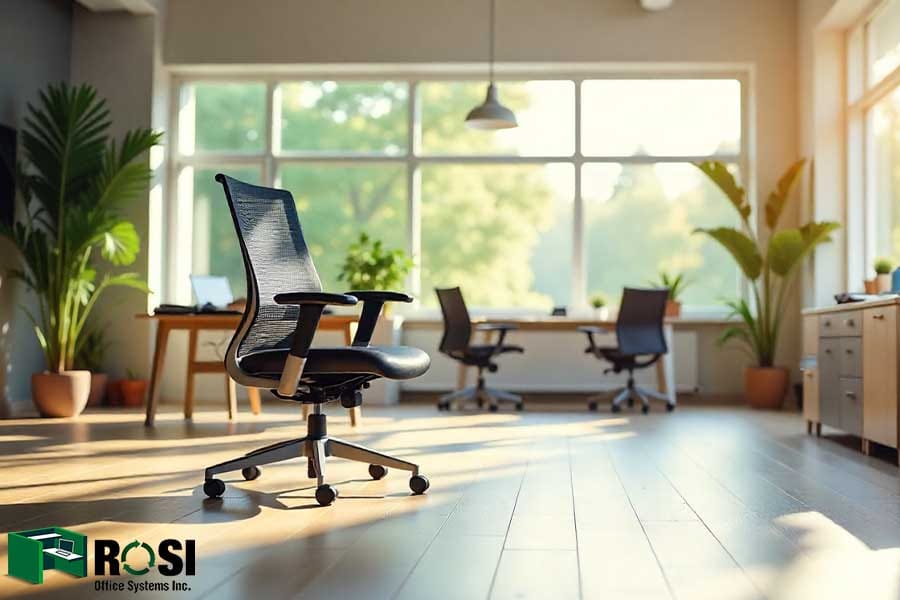
2. Sit-Stand Desks
Another office furniture that we recommend to businesses in our 2026 office furniture buying guide is sit-stand desks.
These desks are one of the most important innovations in the world of office furniture in order to improve employee health and adapt to modern work needs.
Sit-stand desks allow users to easily switch between sitting and standing positions throughout the day.
Regular use of these types of desks reduces pressure on the spine and neck.
A 12-month study by the CDC found that employees who used sit-stand desks reduced their upper back and neck pain by 54%.
3. Accessories for Comfort
One of the most important ergonomic accessories is the monitor arm, which allows you to adjust the height and angle of the monitor so that the screen is positioned exactly in front of your eyes.
Another key piece of equipment is the adjustable keyboard tray, which maintains a natural hand position by providing the right angle for your wrists and arms.
To maintain proper foot position, it is also recommended to use an ergonomic footrest or anti-fatigue mats.
4. Acoustic Solutions
Acoustic solutions, especially in open workspaces, are a vital part of space design, playing a practical role in maintaining employee focus and quality of work.
Wall and ceiling acoustic panels, with their effective absorption of disturbing sounds, make the work environment quieter and enhance concentration.
If your workspace is open, consider options like fabric partitions or phone pods when buying office furniture, especially for private meetings or important phone calls.
Step 4: Flexibility and Adaptability
1. Modular Furniture Systems
One of the key principles in today’s office design that we recommend in our office furniture buying guide is the use of modular office furniture.
Such flexibility allows you to change the layout of the space quickly and at minimal cost, to suit the needs of projects or teams.
2. Multi-Purpose Pieces
In modern 2026 design, the multi-functionality of office furniture is of great importance.
A desk can be used for both individual work and as a small meeting table.
Also, benches with built-in storage space or sofas that can be separated and converted into several independent chairs are examples of this type of furniture that significantly increase space efficiency.
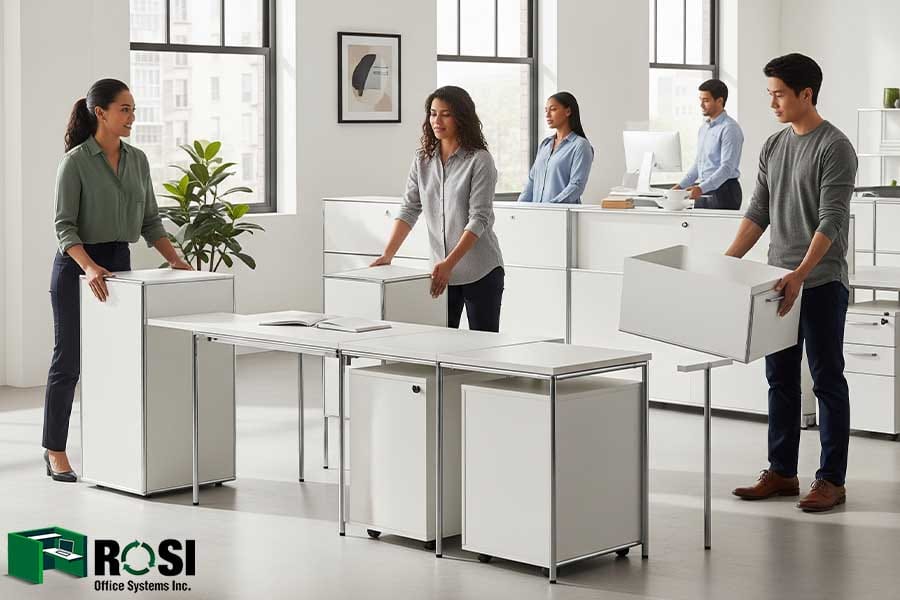
3. Portable and Lightweight Options
Lightweight, wheeled, or folding furniture allows users to quickly rearrange the environment for an impromptu meeting, teamwork, or individual focus.
These types of pieces allow employees to personalize the space to suit their type of activity.
4. Solutions for Hybrid Work
With the rise of hybrid and collaborative work models, the need for office furniture that can be used collaboratively has increased.
Solutions like hot-desking, shared workstations, personal lockers, and flexible workspaces allow employees to access the office anytime, anywhere, without limiting their personal space or performance.
You Might Also Enjoy: What Is Biophilic Furniture: 2026 Guide
Step 5: Smart Integration and Technology
With the advancement of technology and the increasing need for smart offices, office furniture must also be in line with current technologies.
1. Built-in Charging
Today, office desks and workstations should be equipped with advanced charging ports such as USB, so that users can easily charge their laptops, smartphones, or other digital devices.
Additionally, wireless charging pads are also being installed as a practical feature on desk surfaces or meeting tables, allowing users to charge their devices simply by placing them on the table.
2. Integrated Lighting
Smart lighting systems can automatically detect the presence or absence of people using motion sensors and activate or deactivate the lighting of the space accordingly.
Some modern office desks have adjustable built-in lighting that creates optimal conditions for studying, designing, or business meetings.
3. Cable Management
To combat cable clutter and reduce safety hazards, today’s desks and workstations are equipped with internal channels, retention clips, or cable routing boxes.
These solutions effectively prevent tangled wires and ensure that all connections are routed neatly and securely in designated paths.
4. Desk Booking and Occupancy Sensors
Desk Booking and Occupancy Sensors are key technologies in modern workplaces, especially hybrid workplaces where employees are present on a rotating or non-fixed basis.
Using digital reservation systems, employees can reserve their desired desk or meeting room in advance via mobile apps or web platforms.
In addition to saving time, this feature prevents confusion and wasting unused space.
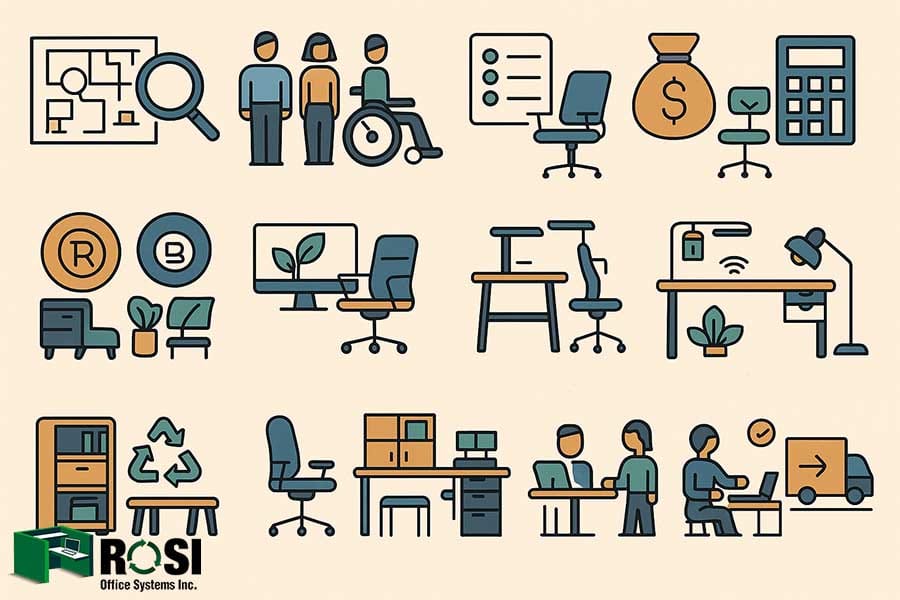
Step 6: Sustainability and Materials
In recent years, attention to environmental sustainability has become one of the fundamental principles in office design and office furniture selection.
1. Eco-Friendly Materials
In the 2026 office furniture buying guide, it is very important to choose furniture that is made using materials that cause the least harm to nature.
Common examples include recycled plastic, metal, or wood, which is obtained from previous manufacturing waste and used in a new cycle.
Also, reclaimed wood, collected from old buildings or sources, is used without the need to cut down new trees.
2. Low-VOC (Volatile Organic Compound) Finishes
Some paints and coatings contain volatile organic compounds (VOCs), which can reduce indoor air quality and cause headaches, allergies, or respiratory problems.
Choosing furniture with low-VOC or no-VOC finishes helps with employee health and workplace safety.
3. Certifications
Environmental certifications play an important role in ensuring the sustainability and health of office furniture.
When buying office furniture for your workplace, paying attention to these certifications will help you make a more responsible and informed choice.
4. Durability and Longevity
Purchasing quality, durable office furniture, while it may be more expensive initially, will reduce waste, replacement costs, and resource consumption in the long run.
Durable furniture usually has a better design and provides a better user experience for employees.
5. Local Sourcing
Choosing local manufacturers and suppliers to buy office furniture is one of the effective strategies for sustainability and environmental responsibility.
This choice reduces greenhouse gas emissions from long-distance transportation and, as a result, reduces the organization’s carbon footprint.
On the other hand, purchasing from local sources helps support the local economy and leads to the growth of small and medium-sized businesses.
Also, the geographical proximity of these suppliers makes after-sales service faster, more convenient, and less expensive.
Step 7: Deep Dive into Essential Furniture Types
In our office furniture buying guide in 2026, we will introduce you to the most essential furniture you should have in your office.
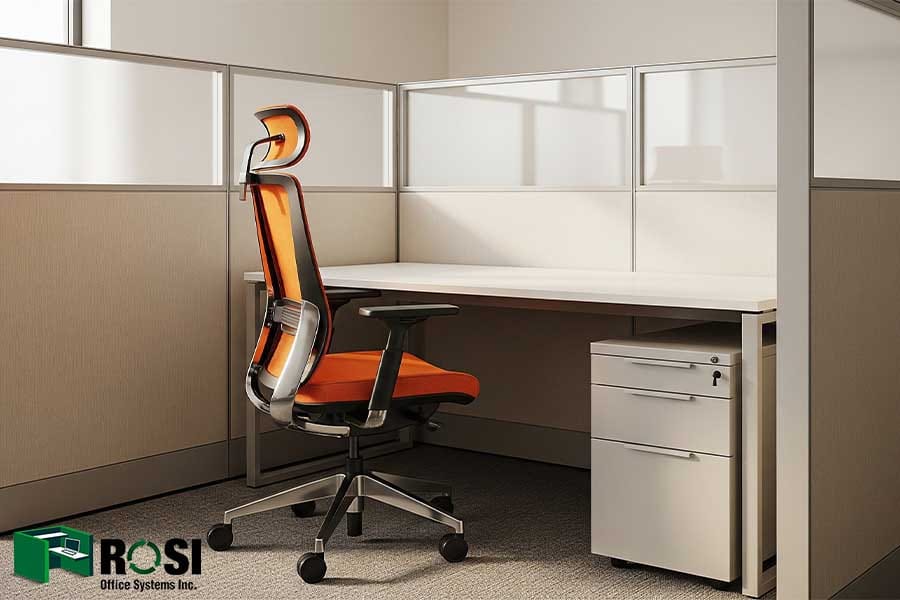
1. Seating
- Task Chairs: These chairs are one of the most important pieces of office furniture in any office, and their design is largely based on ergonomic principles to help maintain proper body posture.
- Executive Chairs: This type of chair combines comfort with a luxurious, professional look.
They are usually made of high-quality materials such as fine leather, and their design is such that, in addition to providing ergonomic support, they also give a distinguished and formal look to the managers’ workspace.
- Meeting and Conference Chairs: These chairs are designed for use in meeting rooms and should provide adequate comfort for long sessions in addition to looking good.
- Lounge and Breakout Seating: This type of office furniture includes sofas, armchairs, and casual chairs that are used for lounges, waiting rooms, or informal areas in the office.
The main purpose of these chairs is to create a friendly, relaxed, and pleasant environment where employees can relax, chat, or informally hold short meetings.
- Specialty Chairs: Specialized chairs are designed for people with special needs, such as employees who are tall or overweight, or people with specific medical conditions such as spinal problems or mobility limitations.
2. Desks and Workstations
- Adjustable Height Desks (Sit-Stand): These office desks Houston allow users to switch between sitting and standing positions throughout the day.
This feature helps reduce fatigue, improve circulation, and increase focus.
- Executive Desks: These desks are designed for more formal spaces, such as executive offices, and are usually larger and have a more striking design.
The use of high-quality materials and a combination with storage space are common features of this type of desk.
- Modular Workstations and Modern Cubicles: For open-plan offices, workstations and office cubicles are a great choice to create privacy along with teamwork.
Their modular design allows you to constantly rearrange the space according to the number of employees and work needs.
These workstations can include low dividers for privacy and shared desks for teamwork.
- Collaborative Tables: These office tables are designed for team meetings, brainstorming, or group projects.
They are usually large, multi-person, and equipped with power outlets, USB, and network ports so people can easily connect their laptops or gadgets.
- Home Office Desks: With the rise of remote working, designing desks that are both efficient and stylish has become increasingly important.
These desks are usually compact and multipurpose.
3. Storage Solutions
In any efficient office space, storage solutions play an important role in maintaining order, providing easy access to documents and equipment, and making optimal use of space.
Office storage solutions include vertical and horizontal filing cabinets, regular cabinets and credenzas for supplies, personal lockers in shared spaces, open shelving for books and decor, and easy-to-move under-desk drawers.
4. Ancillary Furniture and Accessories
- Reception Furniture: The reception area is the first important point of contact between your company’s brand and the visitor.
This furniture includes items such as reception desks, waiting areas, and coffee tables.
- Acoustic Pods and Booths: In busy, open offices, these spaces allow employees to focus, take phone calls, or have short meetings without interruption.
- Whiteboards and Collaboration Screens: These are key tools for collaboration and brainstorming.
- Dividers and Partitions: To define different workspaces without the need for permanent construction, you can use movable or translucent partitions to create privacy without blocking light.
- Lighting: Proper lighting, such as task lighting, along with natural light, improves employee productivity and eye health.
Step 8: The Buying Process: From Research to Installation

1. Research and Selection
In the office furniture buying process, the Research and Selection stage plays a key role and can prevent costly mistakes.
Start by researching online, and manufacturer websites, user reviews, and office furniture blogs are all good sources for comparing quality, price, and styles.
Then, if possible, schedule an in-person visit to the showrooms to closely examine the comfort, build quality, and dimensional fit of the furniture.
2. Supplier Selection
When choosing an office furniture supplier, it is very important to pay attention to reputation and customer reviews.
Choose a supplier that, in addition to being reputable, offers services such as delivery, installation, space layout, and design consulting, and can also customize products.
3. Delivery and Installation
During the furniture delivery and installation phase, careful logistical planning is essential so that the delivery schedule aligns with the office’s conditions and access hours.
Also, professional installation by experienced teams not only ensures safety but also extends the useful life of the furniture.
After installation, it is important to finally inspect all parts for possible damage or defects so that necessary action can be taken promptly if needed.
Conclusion
As discussed in the article The Ultimate Guide to Buy Office Furniture in 2026, key principles such as ergonomics, flexibility, smart integration, and environmental sustainability have become essential requirements in office design.
Therefore, to create a comfortable and flexible work environment, you should pay attention to the important points we have mentioned in this guide and consider all aspects.
Choosing the right furniture is a direct investment in employee health, increased productivity, and enhanced brand identity.
A study by the University of Warwick found that happy employees are 12% more productive — and a well-designed office plays a crucial role in workplace satisfaction.
With a forward-thinking and informed approach, transform your workspace into a platform for sustainable growth and success.

John Ofield is a recognized expert in the office furniture and office cubicle industry in Houston, TX, with over 40 years of experience. As the founder of ROSI Office Systems, he specializes in furniture space planning, custom cubicle designs, modern office chairs and tables, and high-quality commercial furniture. John’s expertise helps businesses enhance productivity and collaboration. He is also dedicated to mentoring entrepreneurs and redefining workspaces to inspire success.